Thermal Ablation Damage Analysis of CFRP Suffering from Lightning Based on Principles of Tomography
Abstract
1. Introduction
2. FEA Models and Experiments
2.1. Specimens and Their FEA Models
2.2. Material Properties
2.3. The Waveform of Lightning Currents
2.4. Observation of the Ablation Damage
3. Processing of Tomography Images
3.1. Temperature Fields Zoning
3.2. Calculation of Ablative Mass Based on Tomographic Images
4. Results
4.1. The Ablation Mass Loss
4.2. The Ablation Morphology
4.3. Evolutions of Ablation Areas
4.4. Fitting Analysis between Ablation Mass Losses and Currents
5. Conclusions
- (1)
- According to different degrees of vaporization and pyrolysis of carbon fiber and resin matrix at different temperatures, the temperature field of CFRP in lightning is divided into Area 0, Area I, Area Ⅱ, and Area Ⅲ with different density loss rates. The calculation accuracy will be improved if the temperature range is divided more finely without considering the simplicity of the calculation process.
- (2)
- The areas of Area I, Area II, and Area III in different tomographic images are calculated by pixel statistics. The total mass loss can be obtained by multiplying the area with the corresponding spacing, density, and mass loss rate. Ablation mass losses are well-matched with that of FEA. The calculation accuracy will increase by shortening the spacing without considering the simplicity of the calculation process.
- (3)
- The maximum ablative area of unprotected CFRP laminates appears underground rather than on the surface due to the surface thermal radiation, while this effect does not appear in copper mesh protected CFRP laminates, because the copper mesh bears most of the lightning current, leading to the ablation area being close to circular at the same time.
- (4)
- The ablative areas of CFRP gradually evolve with the increase in the thickness even in the case of the same ply, and the copper mesh can significantly reduce the anisotropy of ablation areas of CFRP. The anisotropy of ablation areas is closely associated with the cross angle of copper wire, where the ablation areas are close to circular if the angle is 90°, and the ablation areas are close to ellipse if the angle is not 90°.
- (5)
- The quadratic curves are used to fit ablation mass losses. Since the integral of current action is proportional to the lightning energy, the quadratic coefficient of the fitted curve can reflect the ablation energy.
Author Contributions
Funding
Conflicts of Interest
References
- Du, S. Advanced composite materials and aerospace engineering. Acta Mater. Compos. Sin. 2007, 24, 1–12. [Google Scholar]
- Yi, X.; Cao, Z.; Li, H. Aeronautical Composite Technology; Aviation Industry Press: Beijing, China, 2013; pp. 3–14. [Google Scholar]
- Christos, K. Design and Analysis of Composite Structures: With Applications to Aerospace Structures; John Wiley & Sons Ltd.: New Jersey, NJ, USA, 2013; pp. 1–17. [Google Scholar]
- Li, B.; Chang, F.; Xiao, Y. Lightning damage effects of carbon fiber reinforced resin modified by silver powder. Acta Mater. Compos. Sin. 2020, 37, 1911–1920. [Google Scholar]
- Kumar, V.; Yokozeki, T.; Karch, C.; Hassen, A.A.; Hershey, C.J.; Kim, S.; Lindahl, J.M.; Barnes, A.; Bandari, Y.K.; Kunc, V. Factors affecting direct lightning strike damage to fiber reinforced composites: A review. Compos. Part B 2020, 183, 15. [Google Scholar] [CrossRef]
- Ogasawara, T.; Hirano, Y.; Yoshimura, A. Coupled thermal–electrical analysis for carbon fiber/epoxy composites exposed to simulated lightning current. Compos. Part A 2010, 41, 973–981. [Google Scholar] [CrossRef]
- Liu, Z.Q.; Yue, Z.F.; Wang, F.S.; Ji, Y.Y. Combining analysis of coupled electrical-thermal and blow-off impulse effects on composite laminate induced by lightning strike. Appl. Compos. Mater. 2015, 22, 189–207. [Google Scholar] [CrossRef]
- Sun, J.; Yao, X.; Tian, X.; Chen, J.; Wu, Y. Damage Characteristics of CFRP Laminates Subjected to Multiple Lightning Current Strike. Appl. Compos. Mater. 2019, 28, 1–10. [Google Scholar] [CrossRef]
- Luther, G.; Hays, B.S. The Affects of Lightning Strikes and High Current on Polymer Composites. Microsc. Microanal. 2002, 8, 1236–1237. [Google Scholar]
- Feraboli, P.; Miller, M. Damage resistance and tolerance of carbon/epoxy composite coupons subjected to simulated lightning strike. Compos. Part A Appl. Sci. Manuf. 2009, 40, 954–967. [Google Scholar] [CrossRef]
- Wang, B.; Zhu, Y.; Ming, Y.; Yao, X.; Sun, J. Understanding lightning strike induced damage mechanism of carbon fiber reinforced polymer composites: An experimental study. Mater. Des. 2020, 192, 108724. [Google Scholar] [CrossRef]
- Xia, Q.; Zhang, Z.; Mei, H.; Liu, Y.; Leng, J. A double-layered composite for lightning strike protection via conductive and thermal protection. Compos. Commun. 2020, 10, 21. [Google Scholar]
- Yoshiyasu, T.S.; Hirano, N.T. Experimental study on influence of shockwave on composite lightning damage. In Proceedings of the ICOLSE 2019—International Conference on Lightning and Static Electricity, Wichita, KS, USA, 10–13 September 2019. [Google Scholar]
- Shintaro, K.; Yoshiyasu, H.; Takao, O.; Thshio, O. Lightning strike damage behavior of carbon fiber reinforced epoxy, bismaleimide, and polyetheretherketone composites. Compos. Sci. Technol. 2018, 161, 107–114. [Google Scholar]
- Wang, B.; Duan, Y.; Xin, Z.; Yao, X.; Abliz, D.; Ziegmann, G. Fabrication of an enriched graphene surface protection of carbon fiber/epoxy composites for lightning strike via a percolating-assisted resin film infusion method. Compos. Sci. Technol. 2018, 158, 51–60. [Google Scholar] [CrossRef]
- Yousefpour, K.; Lin, W.; Wang, Y.; Park, C. Discharge and ground electrode design considerations for the lightning strike damage tolerance assessment of cfrp matrix composite laminates. Compos. Part B Eng. 2020, 198, 108226. [Google Scholar] [CrossRef]
- Guo, Y.; Xu, Y.; Wang, Q.; Dong, Q.; Yi, X.; Jia, Y. Enhanced lightning strike protection of carbon fiber composites using expanded foils with anisotropic electrical conductivity. Compos. Part A Appl. Sci. Manuf. 2018, 117, 211–218. [Google Scholar] [CrossRef]
- Wang, F.S.; Zhang, Y.; Ma, X.T.; Wei, Z.; Gao, J.F. Lightning ablation suppression of aircraft carbon/epoxy composite laminates by metal mesh. J. Mater. Sci. Technol. 2019, 35, 2693–2704. [Google Scholar] [CrossRef]
- Kawakami, H.; Feraboli, P. Lightning strike damage resistance and tolerance of scarf-repaired mesh-protected carbon fiber composites. Compos. Part A 2011, 42, 1247–1262. [Google Scholar] [CrossRef]
- Nygaard, B.; Nygaard, T.; Court-Payen, M.; Jensen, L.I.; Hegedüs, L. Thyroid volume measured by ultrasonography and ct. Acta Radiol. 2015, 43, 269–274. [Google Scholar] [CrossRef]
- Riegel, A.C.; Berson, A.M.; Destian, S.; Ng, T.; Tena, L.B.; Mitnick, R.J.; Wong, P.S. Variability of gross tumor volume delineation in head-and-neck cancer using ct and pet/ct fusion. Int. J. Radiat. Oncol. Biol. Phys. 2006, 65, 726–732. [Google Scholar] [CrossRef]
- Mata, D.; Horovistiz, A.L.; Branco, I.; Ferro, M.; Ferreira, N.M.; Belmonte, M.; Lopes, M.A.; Sliva, R.F.; Oliveira, F.J. Carbon nanotube-based bioceramic grafts for electrotherapy of bone. Mater. Sci. Eng. C 2014, 34, 360–368. [Google Scholar] [CrossRef]
- Hirano, Y.; Katsumata, S.; Iwahori, Y.; Todoroki, A. Artificial lightning testing on graphite/epoxy composite laminate. Compos. Part A Appl. Sci. Manuf. 2010, 41, 1461–1470. [Google Scholar] [CrossRef]
- Katunin, A.; Sul, P.; Andrze, J.; Dragan, K.; Krukiewicz, K.; Turczyn, R. Damage resistance of csa-doped pani/epoxy cfrp composite during passing the artificial lightning through the aircraft rivet. Eng. Fail. Anal. 2017, 82, 116–122. [Google Scholar] [CrossRef]
- ASTM. D7137/D7137M-12, Standard Test Method for Compressive Residual Strength Properties of Damaged Polymer Matrix Composite Plates; ASTM International: West Conshohocken, PA, USA, 2012. [Google Scholar]
- Yao, X.; Guo, C.; Sun, J.; Chen, L. Damage Simulation and Experiment of Carbon Fiber Composites Subjected to Lightning Current. High Volt. Eng. 2017, 43, 1400–1408. (In Chinese) [Google Scholar] [CrossRef]
- Hanping, H. Heat Conduction Theory; University of Science and Technology of China Press: Hefei, China, 2010. [Google Scholar]
- Junfeng, J. Research of Thermal Contact Effect on Metal/Composite Mechanical Connection. Master’s Thesis, Wuhan University of Technology, Wuhan, China, 2015. [Google Scholar] [CrossRef]
- Abdelal, G.; Murphy, A. Nonlinear numerical modelling of lightning strike effect on composite panels with temperature dependent material properties. Compos. Struct. 2014, 109, 268–278. [Google Scholar] [CrossRef]
- AE-2 Lightning Committee. SAE ARP 5412B, Aircraft Lightning Environment and Related Test Waveforms; SAE International: Warrendale, PA, USA, 2018. [Google Scholar]
- Jialei, Z.; Guodong, L.; Weiping, W.; Cangli, L. Simulation to thermal ablation of carbon fiber reinforced composites under laser irradiation. High Power Laser Part. Beams 2013, 25, 1888–1892. [Google Scholar] [CrossRef]
- Xiao, Y. Study on Matrix Modification and Lightning Damage Characteristics of Composite; Air Force Engineering University: Xi’an, China, 2018. [Google Scholar]
- Xiao, Y.; Yin, J.; Li, S.; Yao, X.; Chang, F.; Zhang, X. Lightning strike damage test research for carbon fiber/epoxy resin matrix composite laminates when subjected to combined lightning current waveforms. Acta Mater. Compos. Sin. 2018, 35, 1436–1442. [Google Scholar]
- Jun, Q. Relationship between Pure Copper Oxidation and Temperature. J. Henan Mech. Electr. Eng. Coll. 2018, 7, 692–702. [Google Scholar]
- Wan, G.; Dong, Q.; Zhi, J.; Guo, Y.; Yi, X.; Jia, Y. Analysis on electrical and thermal conduction of carbon fiber composites under lightning based on electrical-thermal-chemical coupling and arc heating models. Compos. Struct. 2019, 229, 111486. [Google Scholar] [CrossRef]
- Bojowald, M.; Kiefer, C.; Moniz, P.V. Quantum cosmology for the 21st century: A debate. Physic 2010, 3, 589. [Google Scholar]
- Hill, R.D. A survey of lightning energy estimates. Rev. Geophys. 1979, 17, 155. [Google Scholar] [CrossRef]

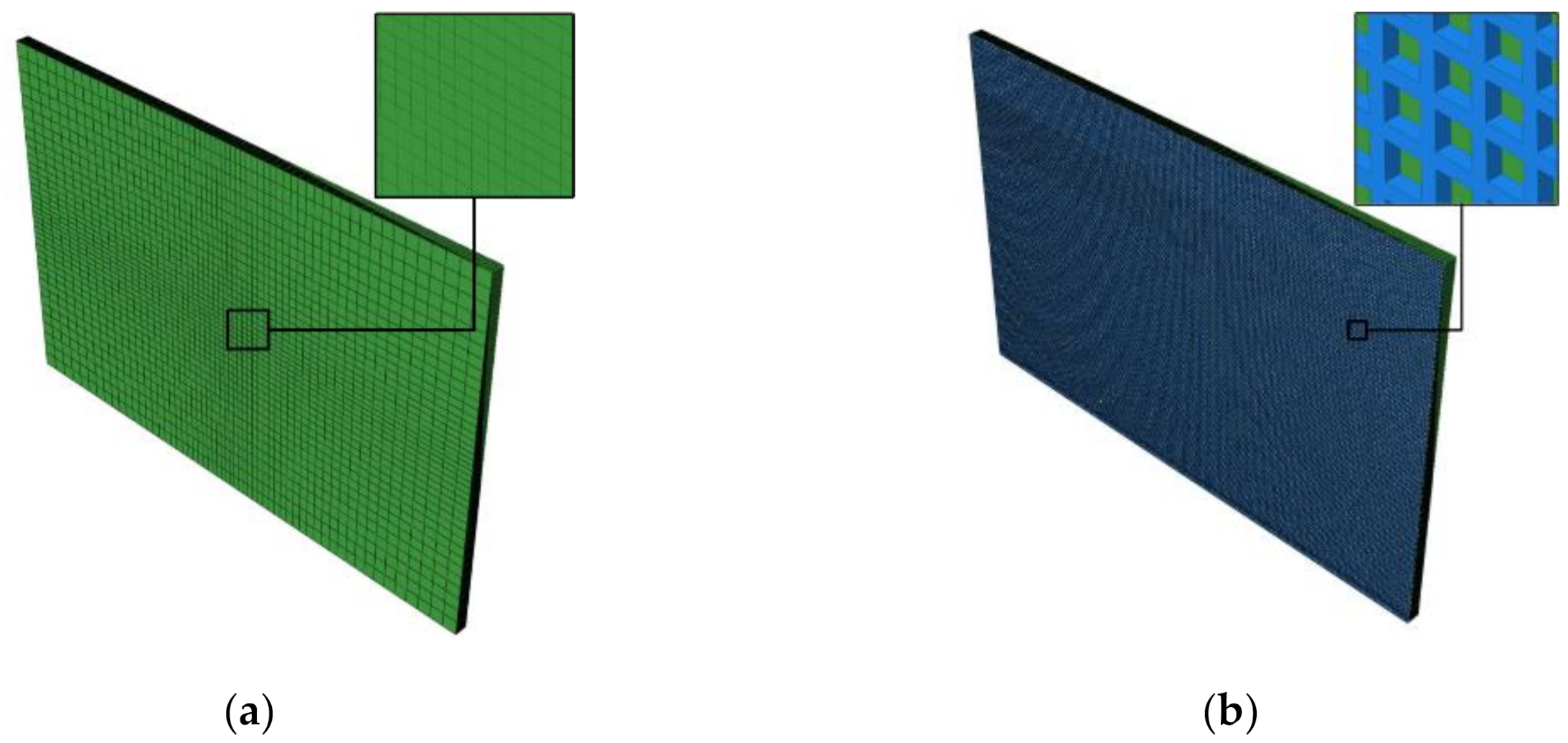

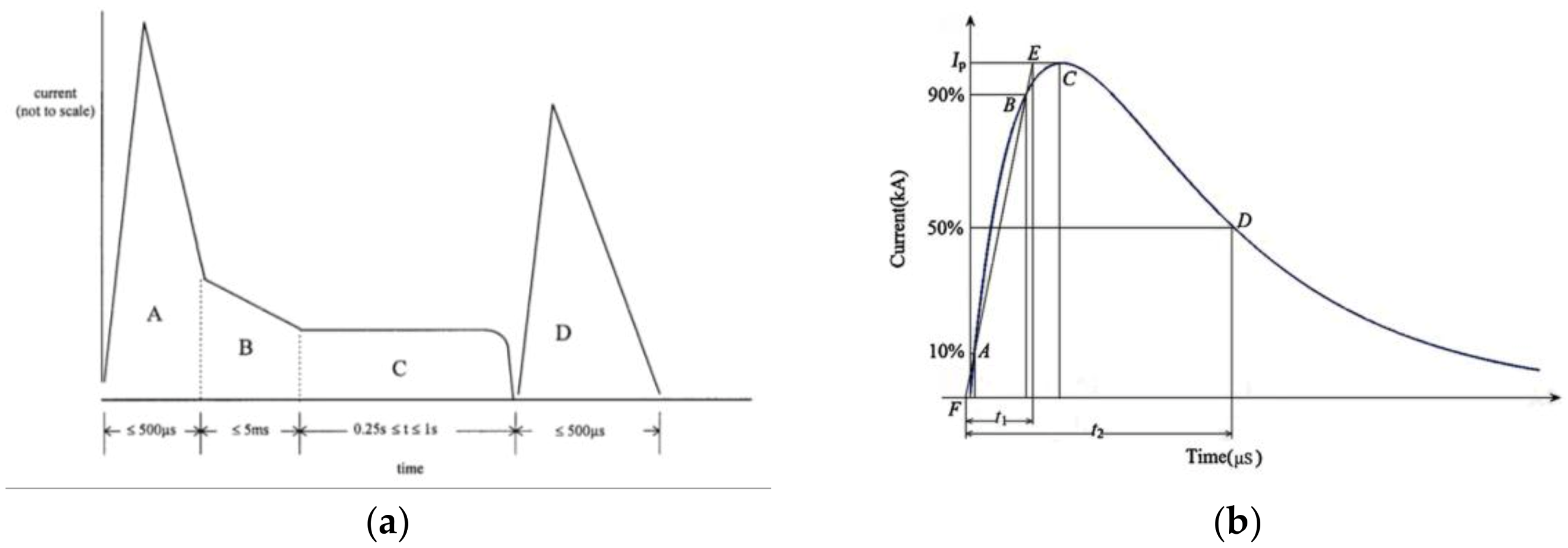
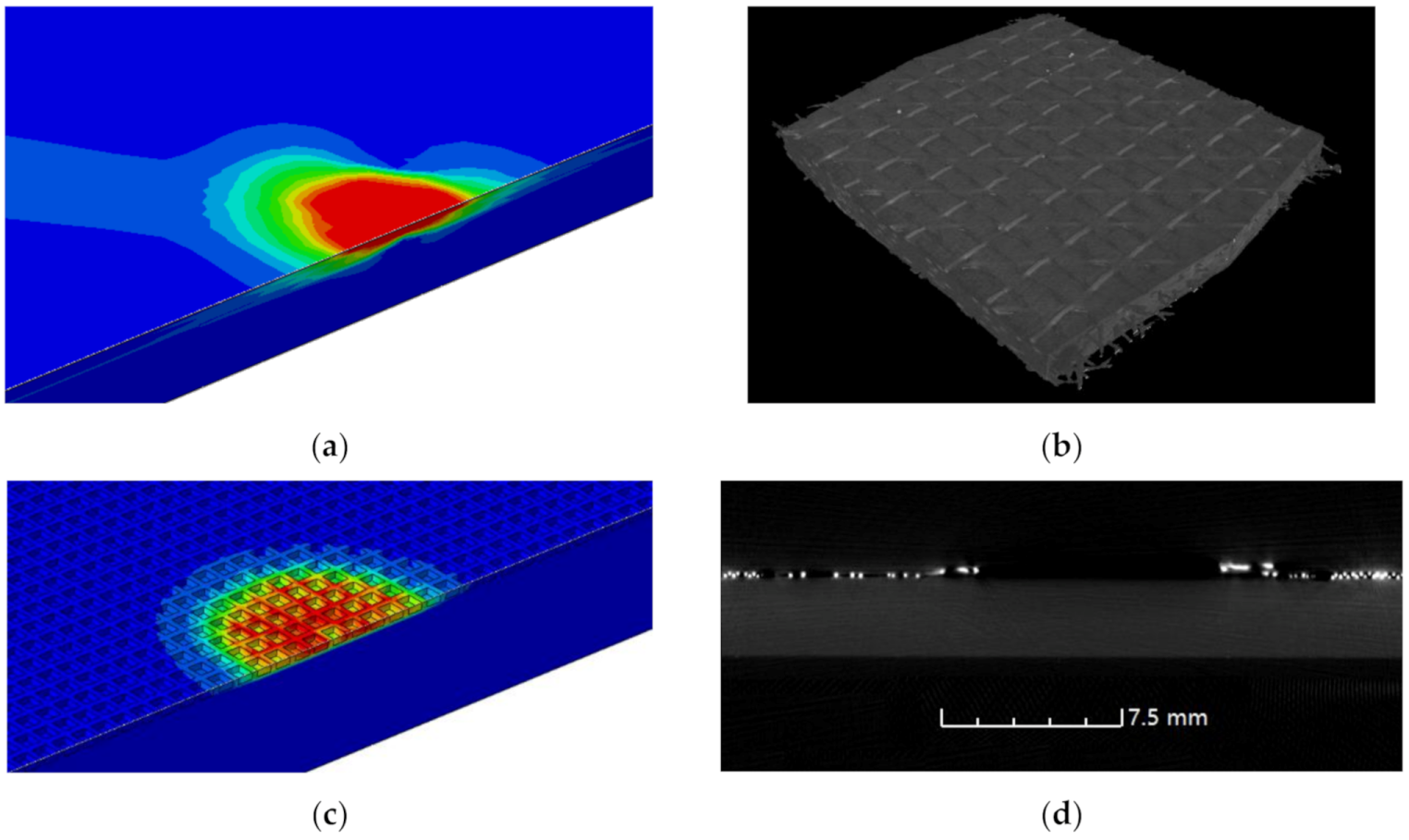
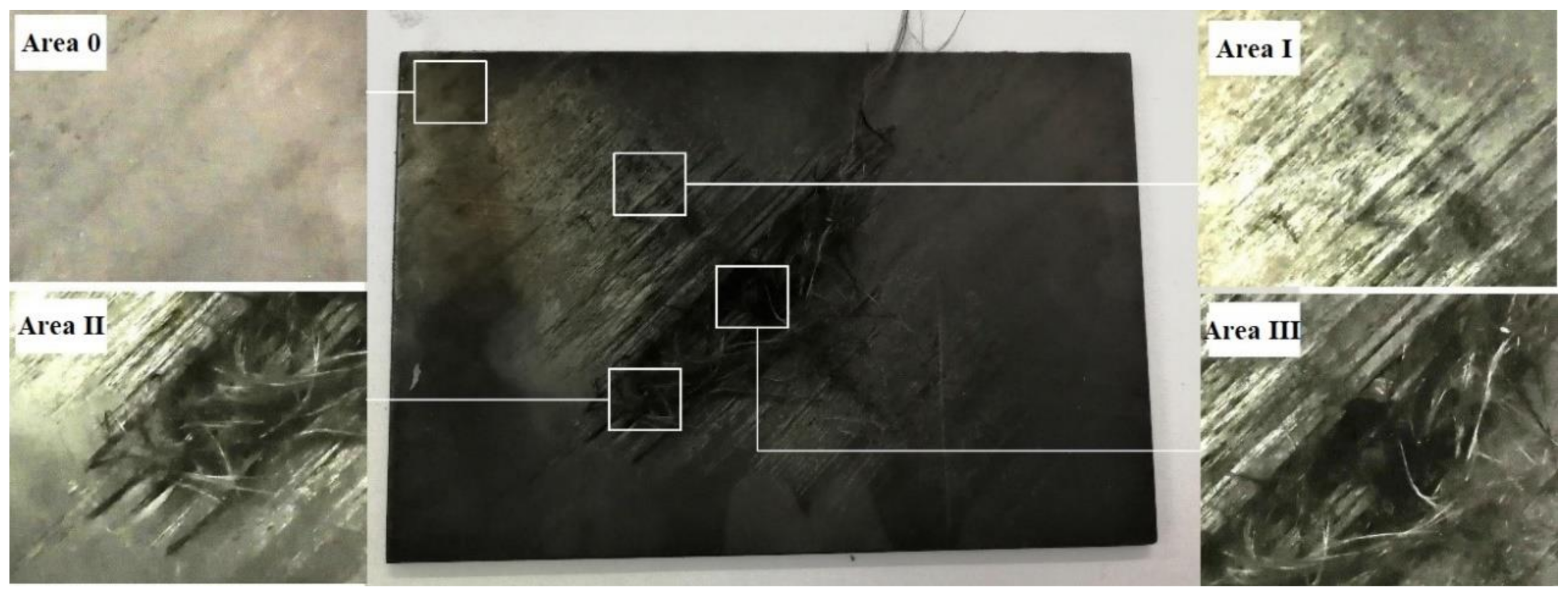

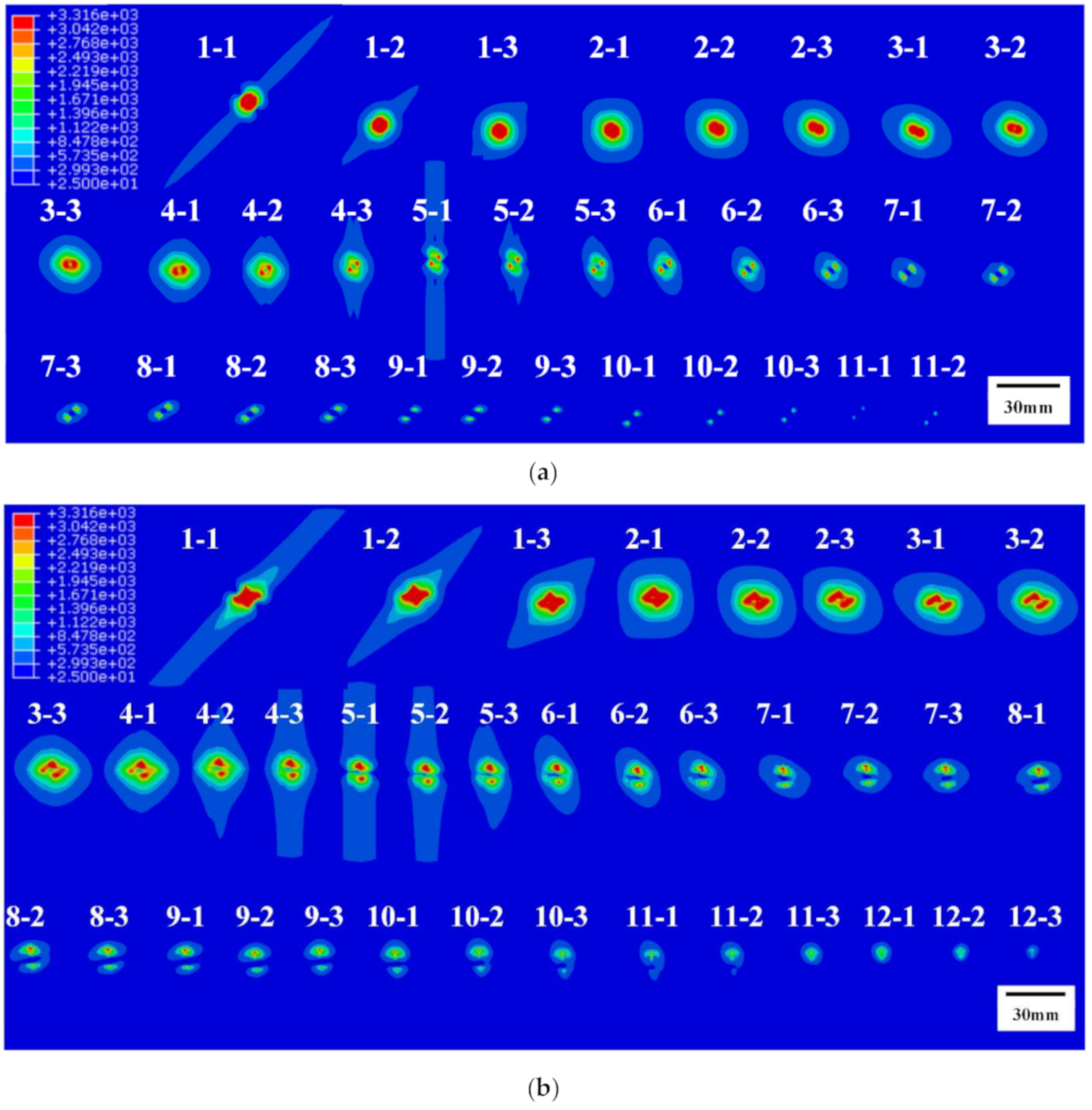
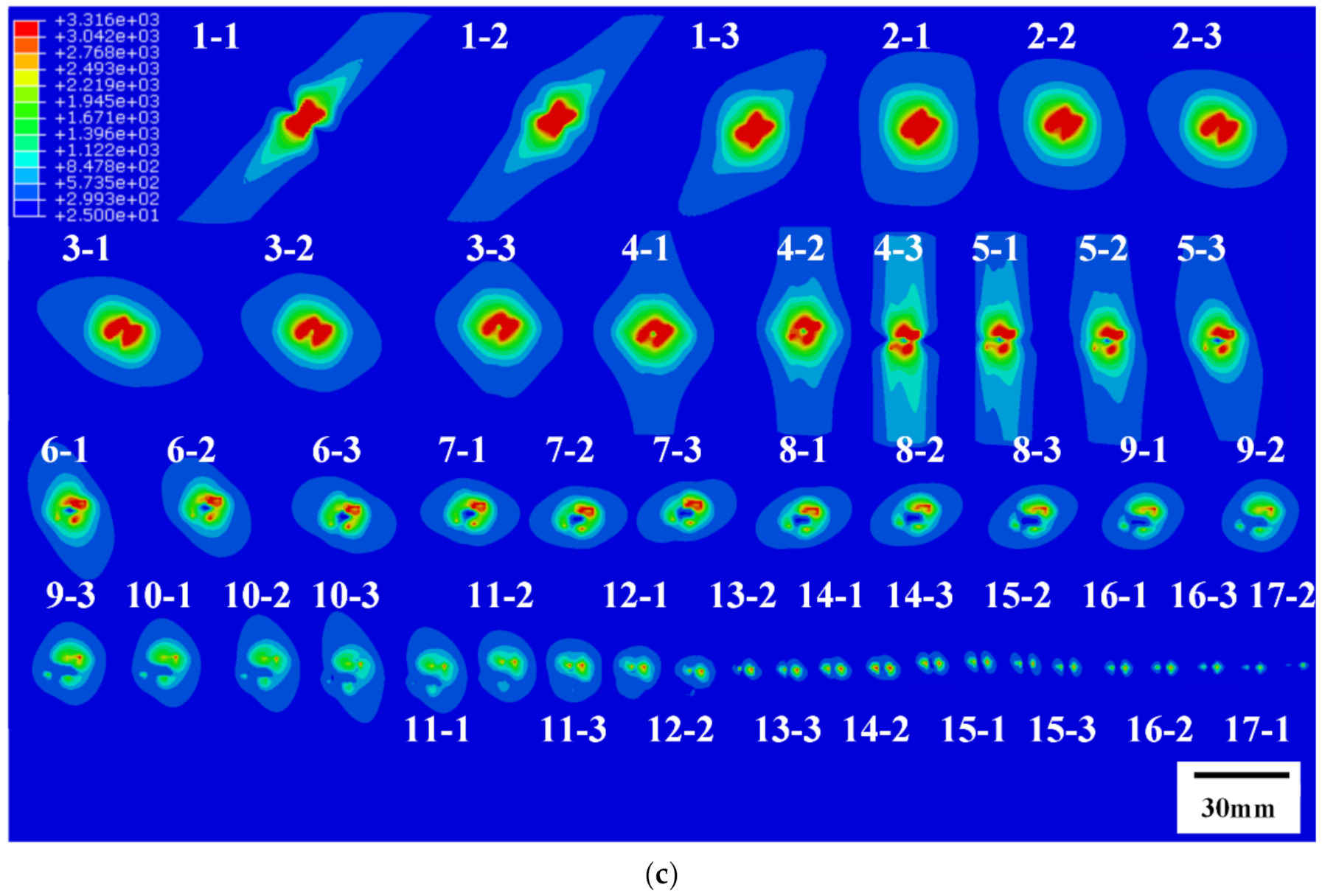

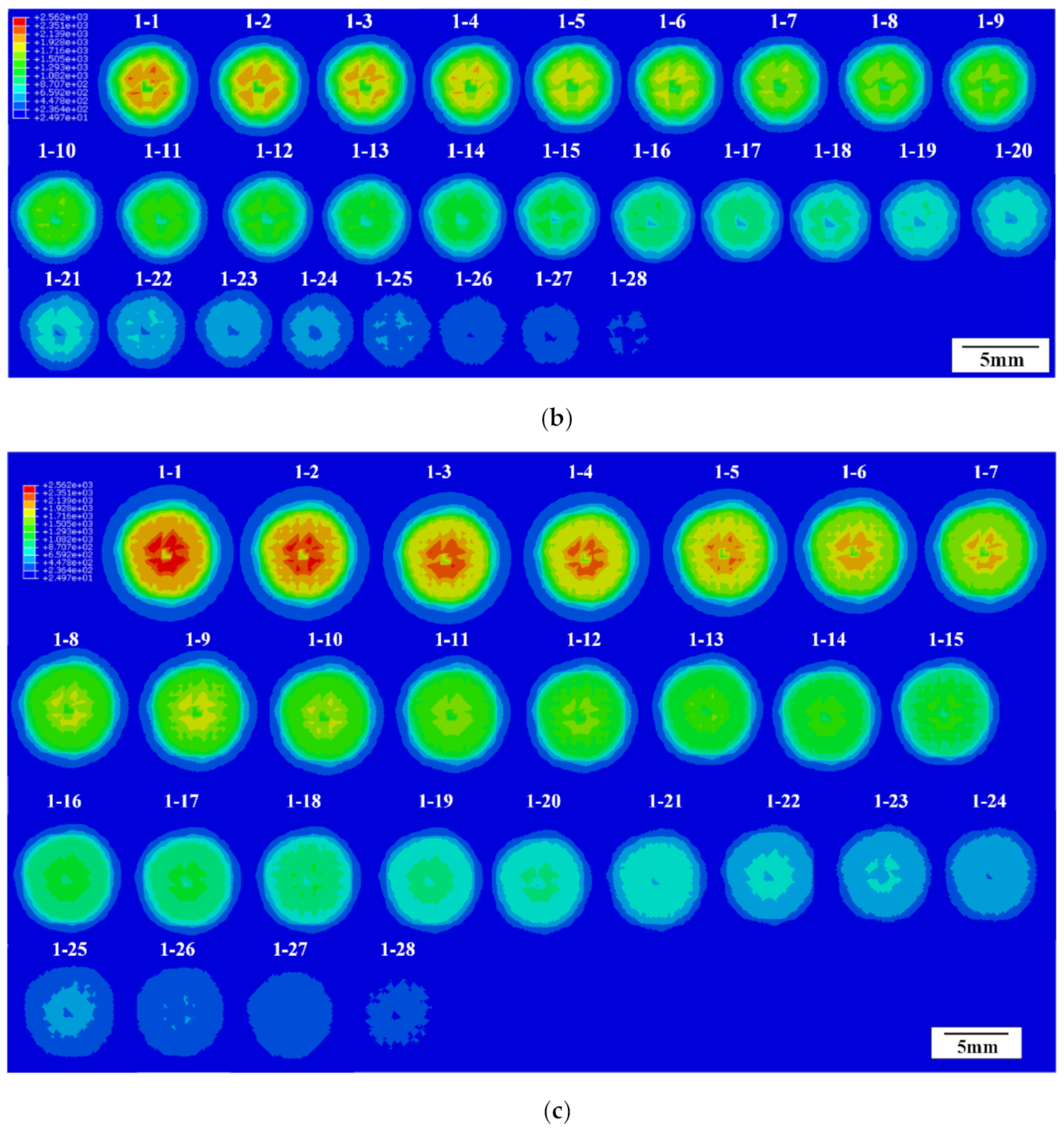
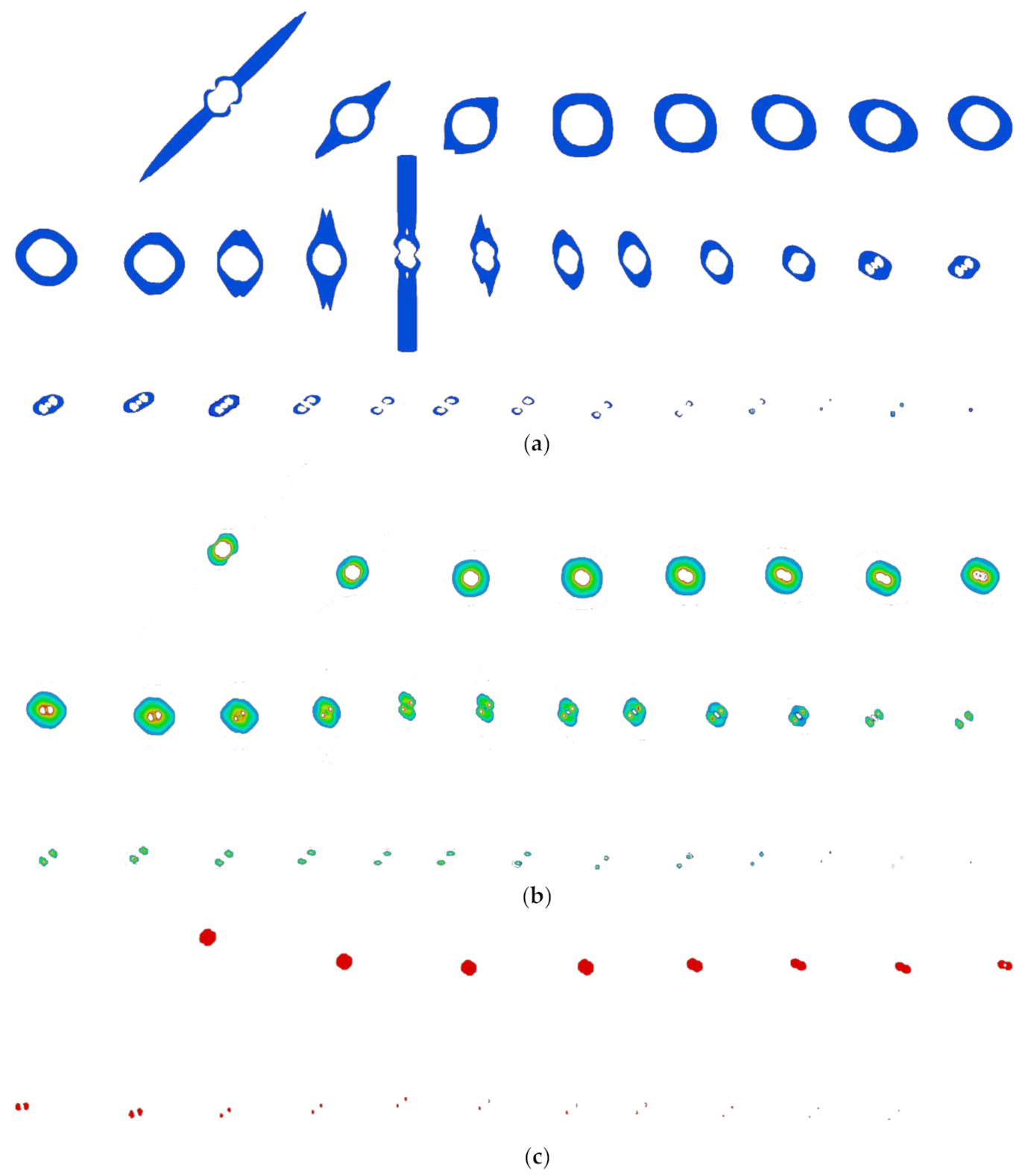
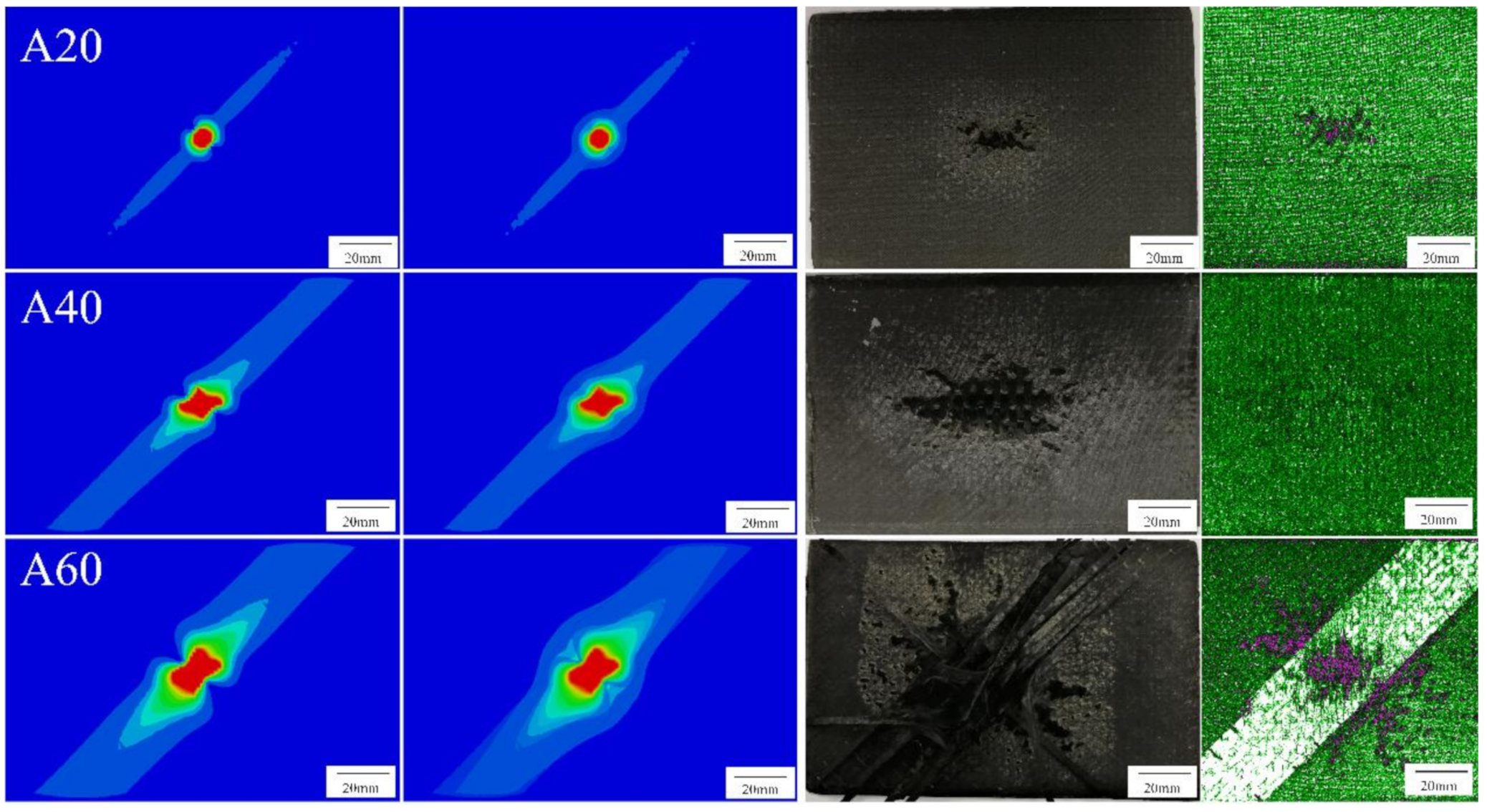
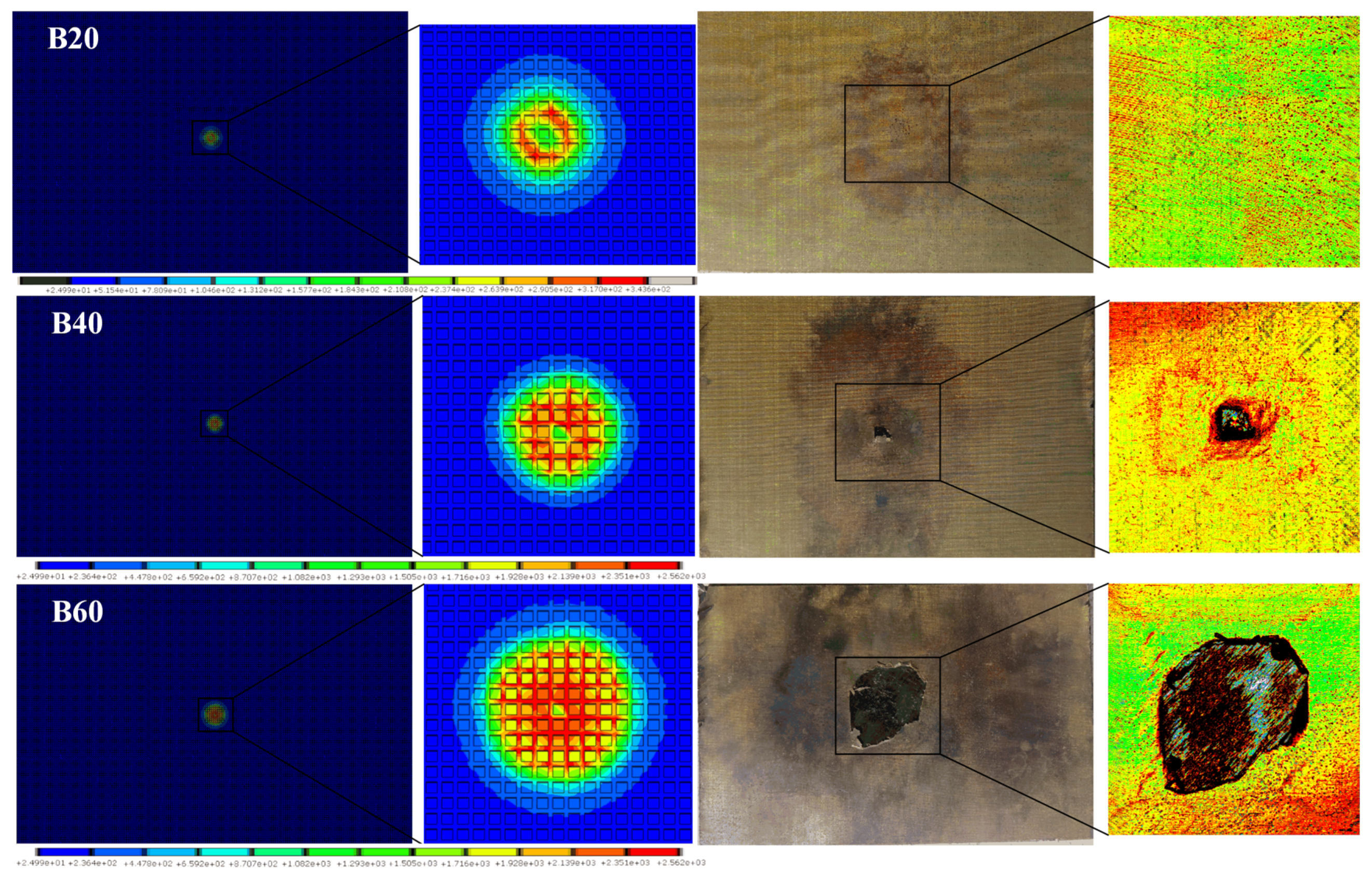
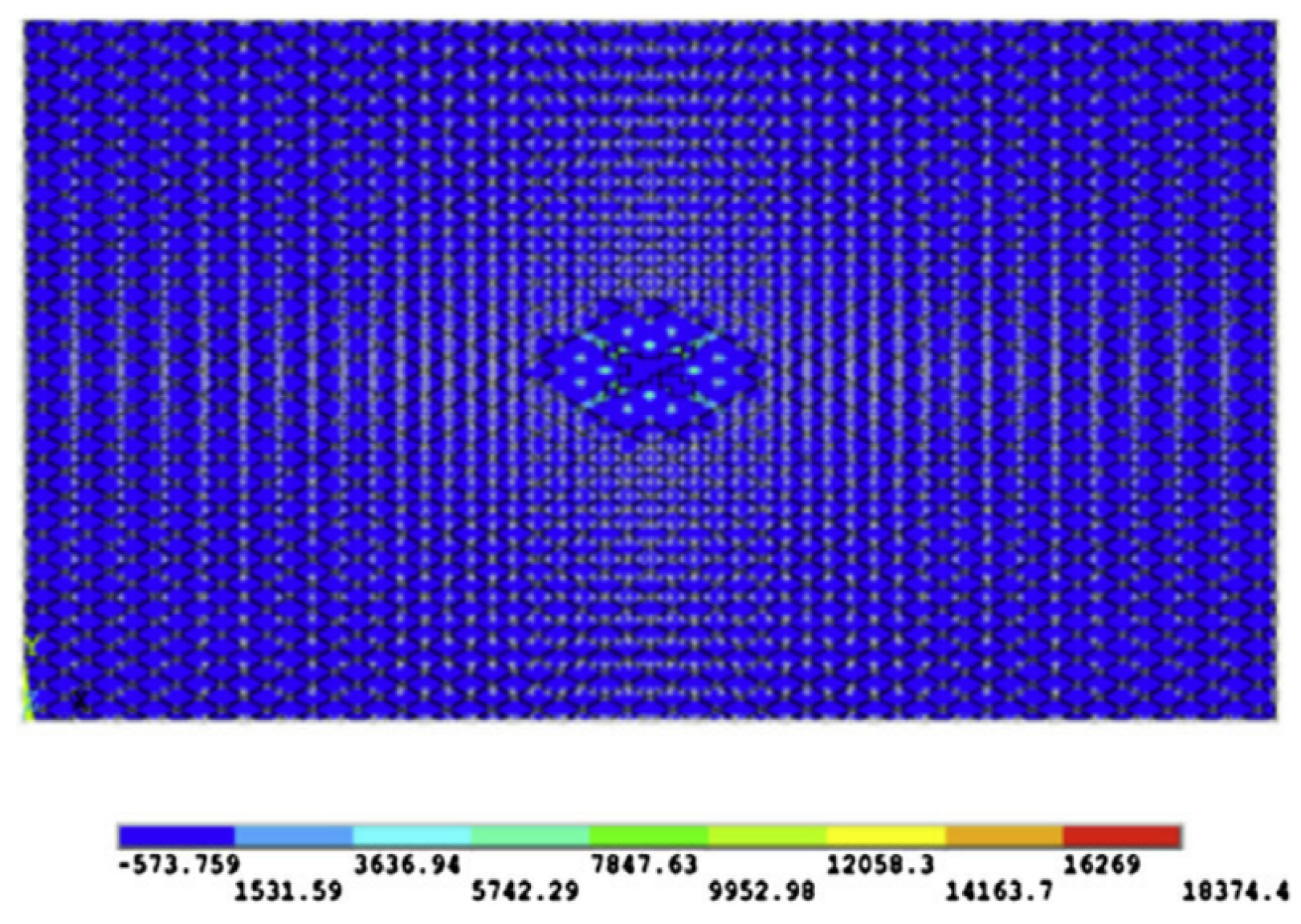
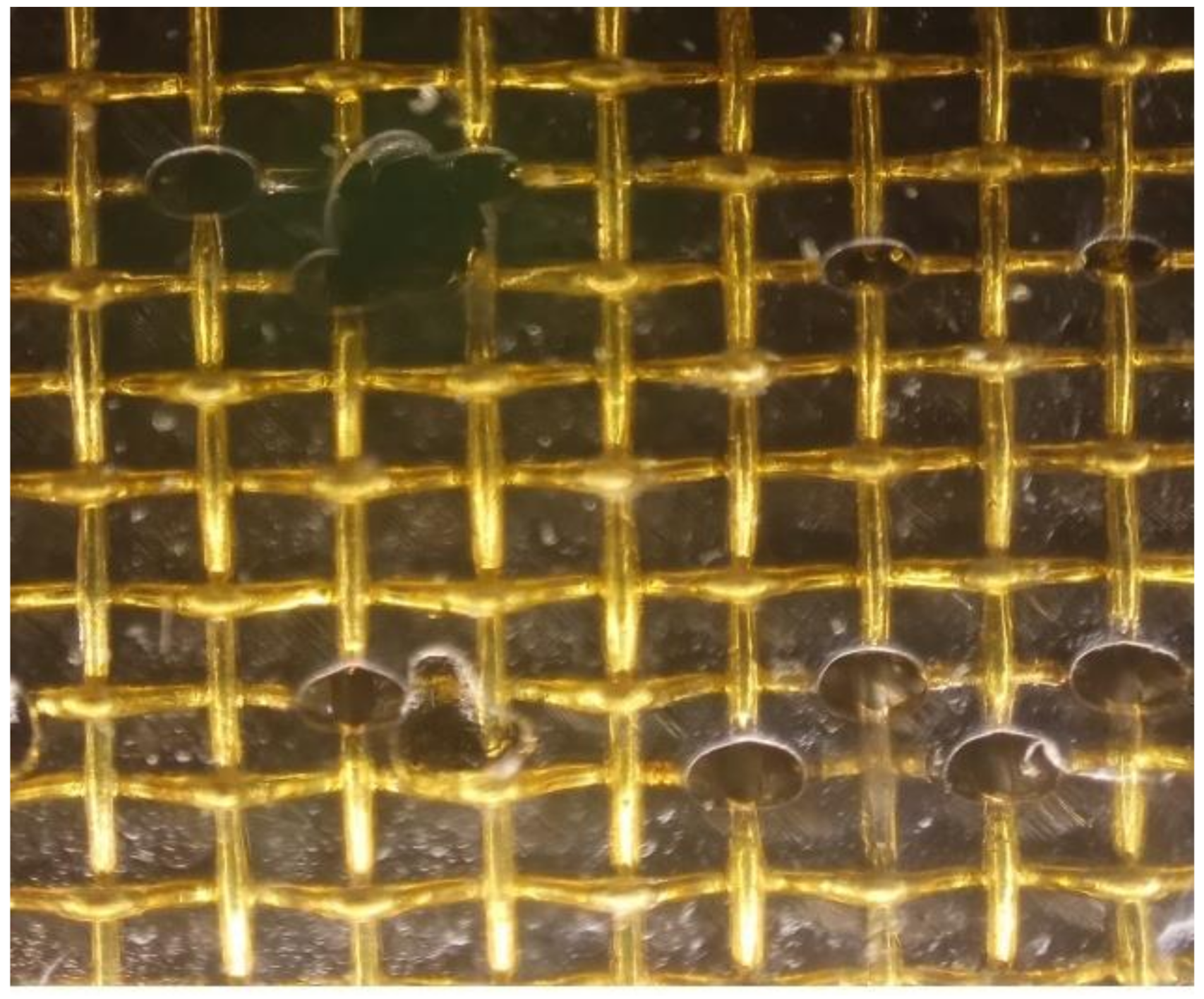
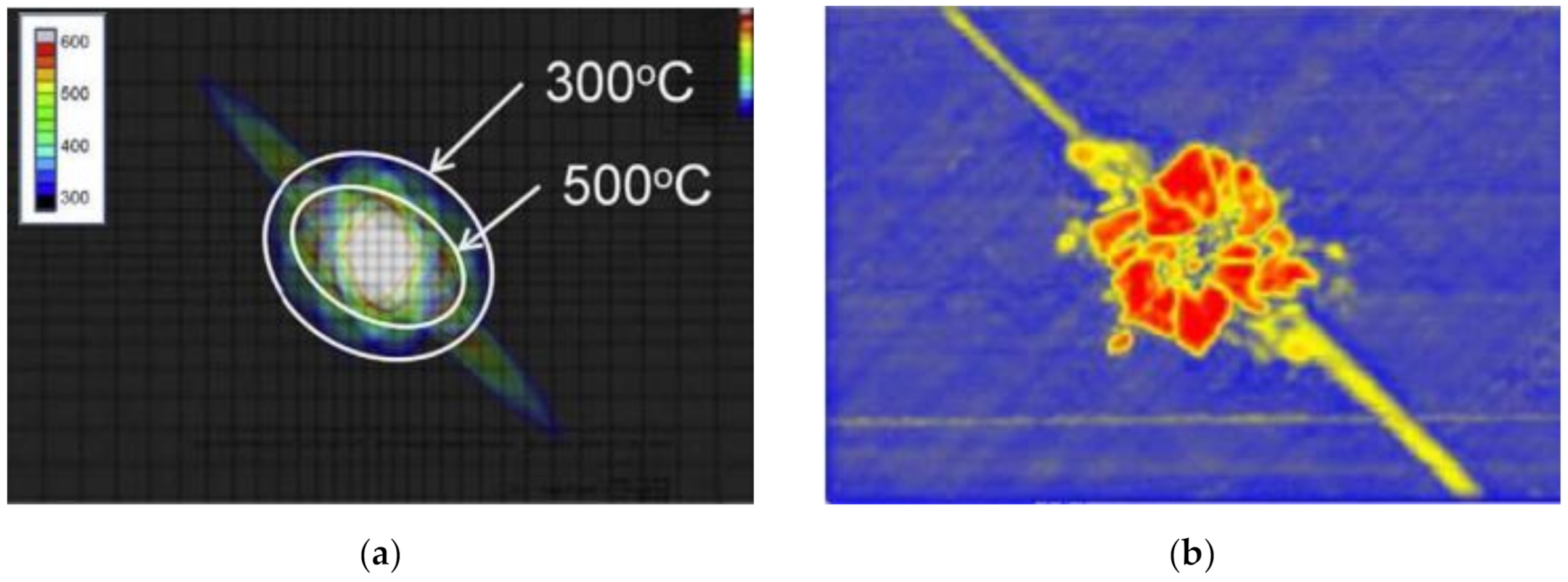

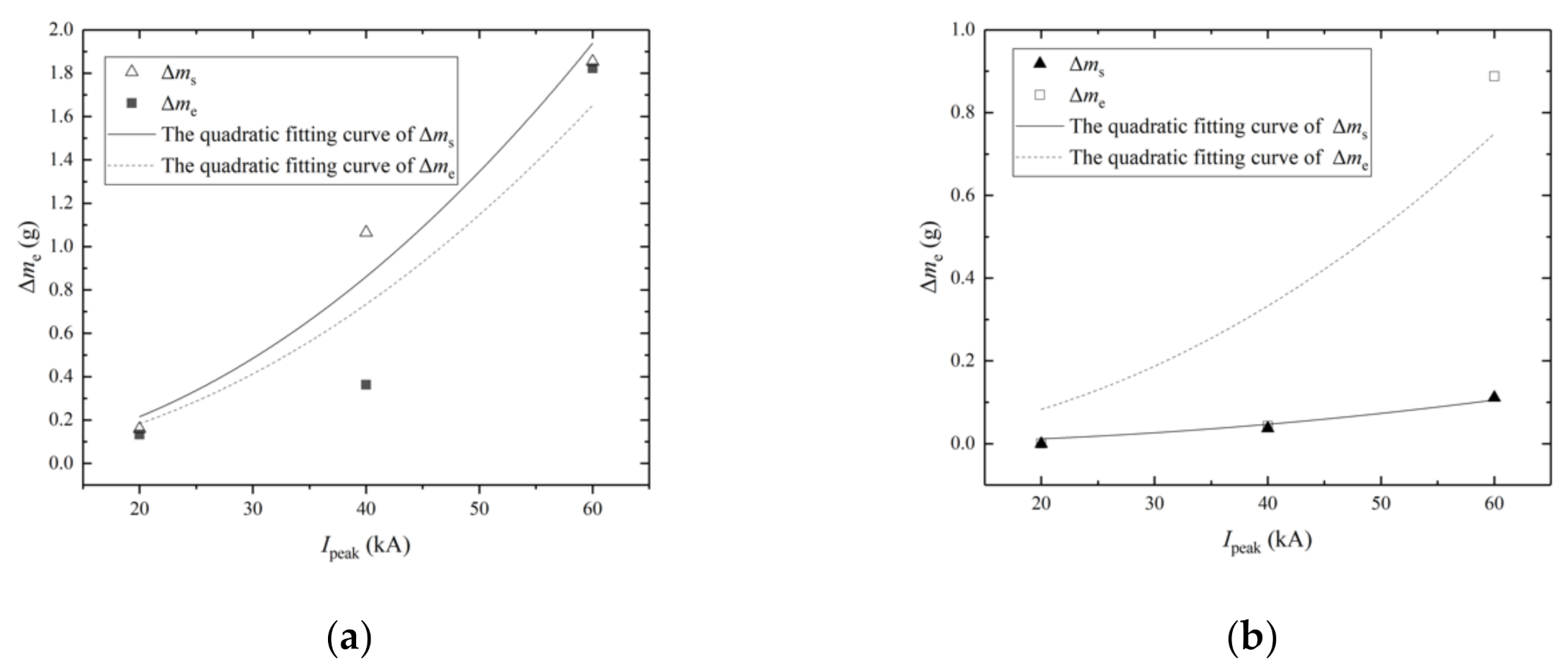
| T (°C) | ρ (J·kg−1·K−1) | Cp (J·kg−1·K−1) | σ (S·m−1) | λ (W·m−1·K−1) | ||||
|---|---|---|---|---|---|---|---|---|
| σx | σy | σz | λx | λy | λz | |||
| 25 | 1520 | 1065 | 29,300 | 77.8 | 0.07 | 11.8 | 0.609 | 0.609 |
| 300 | 1520 | 2100 | 29,300 | 77.8 | 0.07 | 11.8 | 0.609 | 0.609 |
| 400 | 1520 | 2100 | 29,300 | 778 | 7.94 | 2.608 | 0.18 | 0.18 |
| 600 | 1100 | 2100 | 29,300 | 2000 | 2000 | 1.736 | 0.1 | 0.1 |
| 3316 | 1100 | 2509 | 29,300 | 2000 | 2000 | 1.376 | 0.1 | 0.1 |
| >3316 | 1100 | 5875 | 200 | 200 | 1e8 | 1.015 | 0.1 | 0.1 |
| T(°C) | ρ(J·kg−1·K−1) | Cp(J·kg−1·K−1) | σ(S·m−1) | λ(W·m−1·K−1) |
| 25 | 8950 | 385 | 58,140,000 | 401 |
| 500 | 8500 | 431 | 20,120,000 | 370 |
| 510 | 8490 | 431 | 4,651,000 | 339 |
| 1000 | 7945 | 490.952 | 3,704,000 | 150 |
| 2562 | 7600 | 490.952 | 2,227,000 | 180 |
| >2562 | 7600 | 550 | 108 | 180 |
| Number | Protection Modes | Waveform | Ip(kA) | t1 (μs) | t2 (μs) | E (A2s) | Q (C) |
|---|---|---|---|---|---|---|---|
| A20 | Unprotected | D | 20kA | 17 | 168 | 46,316 | 4.13 |
| A40 | 40kA | 185,267 | 8.26 | ||||
| A60 | 60kA | 416,851 | 12.38 | ||||
| B20 | Copper mesh protected | 20kA | 46,316 | 4.13 | |||
| B40 | 40kA | 185,267 | 8.26 | ||||
| B60 | 60kA | 416,851 | 12.38 |
| Area | Temperature Range | Vaporize and Pyrolysis | Density Loss (g/cm3) | Rate |
|---|---|---|---|---|
| 0 | <300 °C | None | 0 | 0 |
| I | 300–573.5 °C | Part of resin | 0.456 | 30% |
| II | 573.5–3000 °C | All resin and little CF | 0.684 | 45% |
| III | 3042–3316 °C | All resin and most CF | 1.444 | 95% |
| Number | St (cm2) | nt | nⅠ | nⅡ | nⅢ | ΔmCFRP (g) | ΔmCu (g) |
|---|---|---|---|---|---|---|---|
| A20 | 424.2258341 | 292,560 | 22,886 | 14,329 | 1209 | 0.159381 | N/A |
| A40 | 1555.492525 | 101,898 | 13,771 | 9823 | 668 | 1.065747 | N/A |
| A60 | 1783.498801 | 280,952 | 58,147 | 40,706 | 2787 | 1.853072 | N/A |
| B20 | 28.89050453 | 380,554 | 142 | 0 | 0 | 0 | 0.000002 |
| B40 | 12.81793357 | 356,420 | 76,116 | 80,918 | 0 | 0.001619 | 0.035803 |
| B60 | 37.18111485 | 175,168 | 34,028 | 38,480 | 0 | 0.00444 | 0.106569 |
| Number | m1 (g) | m2 (g) | Δm (g) | Δm’ (g) |
|---|---|---|---|---|
| A20 | 90.9002 | 90.7664 | 0.1338 | −0.025581 |
| A40 | 98.5323 | 98.1691 | 0.3632 | −0.702547 |
| A60 | 90.3072 | 88.4848 | 1.8224 | −0.030672 |
| B20 | 82.3034 | 82.3033 | 0.0001 | 0.000098 |
| B40 | 82.5386 | 82.4958 | 0.0428 | 0.005378 |
| B60 | 84.2135 | 83.326 | 0.8875 | 0.776491 |
| Parameter | A | R-Squared |
|---|---|---|
| The experiment’s curve of Group A | 4.58883 × 10−4 | 0.89917 |
| The FEA’s curve of Group A | 5.38266 × 10−4 | 0.96372 |
| The experiment’s curve of Group B | 2.08133 × 10−4 | 0.77993 |
| The FEA’s curve of Group B | 2.93054 × 10−5 | 0.95966 |
Publisher’s Note: MDPI stays neutral with regard to jurisdictional claims in published maps and institutional affiliations. |
© 2020 by the authors. Licensee MDPI, Basel, Switzerland. This article is an open access article distributed under the terms and conditions of the Creative Commons Attribution (CC BY) license (http://creativecommons.org/licenses/by/4.0/).
Share and Cite
Li, B.; Chang, F.; Xiao, Y.; Wei, X.; He, W.; Ming, Y. Thermal Ablation Damage Analysis of CFRP Suffering from Lightning Based on Principles of Tomography. Materials 2020, 13, 5159. https://doi.org/10.3390/ma13225159
Li B, Chang F, Xiao Y, Wei X, He W, Ming Y. Thermal Ablation Damage Analysis of CFRP Suffering from Lightning Based on Principles of Tomography. Materials. 2020; 13(22):5159. https://doi.org/10.3390/ma13225159
Chicago/Turabian StyleLi, Bin, Fei Chang, Yao Xiao, Xiaolong Wei, Weifeng He, and Yueke Ming. 2020. "Thermal Ablation Damage Analysis of CFRP Suffering from Lightning Based on Principles of Tomography" Materials 13, no. 22: 5159. https://doi.org/10.3390/ma13225159
APA StyleLi, B., Chang, F., Xiao, Y., Wei, X., He, W., & Ming, Y. (2020). Thermal Ablation Damage Analysis of CFRP Suffering from Lightning Based on Principles of Tomography. Materials, 13(22), 5159. https://doi.org/10.3390/ma13225159





